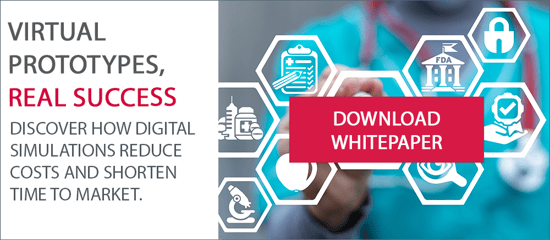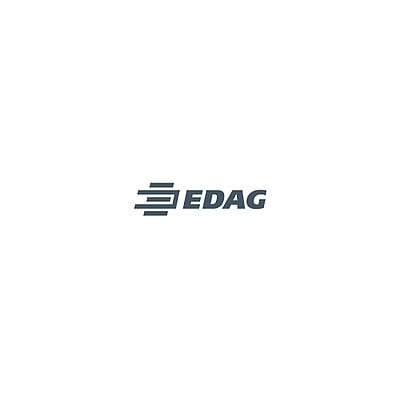Simulations instead of prototypes, virtual instead of physical test devices: Digital development tools reduce costs and accelerate not only the development cycle but also the approval process – at least in the US. However, many manufacturers are still failing to exploit this potential for efficiency. With the help of suitable partners, you can quickly realize cost and time savings.
Companies in the medical technology and pharmaceutical industries are under enormous pressure to innovate. At the same time, requirements are high and development cycles are expensive. A significant portion of the time and cost is spent on the final step of the development process: meeting regulatory requirements for market access, which accounts for between 50 and 80 percent of total development costs.
There are some significant differences between the European and US markets. One aspect is the different treatment of results from the fields of computer-aided engineering (CAE) and computational modeling and simulation (CMS). Here, the approach of the US Food and Drug Administration (FDA) currently offers advantages that enable faster market access. It is therefore interesting for medical device manufacturers to prefer the US as the market for the initial approval of new developments. This allows them to enter the market and generate profits while the more lengthy approval process in the EU is still ongoing.
Focus on product safety
The increasing complexity of modern medical devices brings new challenges: In addition to pure mechanics, electronics, software, and connectivity are playing an increasingly important role. This leads to multidisciplinary development processes in which many different parameters must be coordinated. This problem is exacerbated when new technologies further increase complexity, such as the use of artificial intelligence (AI).
All these developments carry potential risks to the life and limb of users and patients. At the latest during the approval process, manufacturers must prove that these risks have been eliminated or at least minimized to an acceptable level. The effort required for testing, documentation, and validation increases accordingly, which ties up time and resources. New approaches are needed to meet these requirements.
The question of how new products can be brought to market safely is answered differently in the US than in Brussels. Similar to other industries where digital simulation methods have proven to be a useful and reliable tool in safety-related areas, the FDA allows the use of CAE not only in the development process but also in the approval process.
Simulation as an accelerator and efficiency factor
In order to exploit the resulting efficiency potential, medical device manufacturers are faced with the task of "extending" existing approaches to the use of CAE from the development process to the approval process. In some cases, there are also previously untapped opportunities to expand the use of simulations in the development phase.
Virtual prototypes based on CAE make it possible to digitally model, test, and optimize products—for example, based on existing designs using computer-aided design (CAD)—before a physical prototype is built. These simulation-supported development processes not only save costs, but also create transparency and control. Stress tests, flow analyses, material behavior under real conditions: all of this can be realistically reproduced with digital models. The result: significantly shorter development times, reduced risk, and faster innovation.

Figure 1: Left: Calculation of the deformation of a peristaltic pump using FEM; right: Transfer of the deformation and simulation of blood flow using CFD.
Simulation also enables constant comparison between the target and actual states. Changes in design or material parameters can be immediately examined for their effects. Iterations are completed much faster because feedback loops can be closed within hours instead of days or weeks. The insights gained can be incorporated directly into the CAD model – a seamless, digital cycle.
Another economic argument: reducing the number of physical prototypes not only lowers material and manufacturing costs, but also the costs of complex test environments. Setting up test series is particularly expensive for complex systems with high safety requirements. Digital simulations provide a reliable preliminary stage for real-world validation.
This can be proven with concrete figures. For example, developing a cardiovascular stent for treating arterial narrowing using conventional methods costs around US$2 million, and approval takes an average of 18 months, in some cases even two full years. In contrast, a CAE-supported development process led to success after just eleven months, with cost savings of around 70 percent, according to a consortium study by the MedTech Cluster Alliance in 2024.
Predictability and validation in a regulated environment
A key advantage of digital simulation is its predictability: automated simulation chains and variant analyses enable developers to estimate at an early stage which design decisions will have what effects. This is a key factor in regulated environments in particular, as the results can be digitally documented, validated in a traceable manner, and prepared for audits. This makes it possible to demonstrate product safety and regulatory compliance more efficiently in the approval process at the end of development.
In addition, CAE tools can be used to perform risk assessments based on a sound data foundation early on in the process, e.g., using the finite element method (FEM). This allows potential weak points to be identified before they arise in expensive late phases. Functional verification and safety analyses can also be prepared digitally – a major advantage for dialogue not only with the US FDA, but also with testing organizations and notified bodies in the European approval process.
Model-based product development with external support
Despite all these advantages, the use of simulations in the approval process currently still lags far behind its potential. Many companies find it difficult to transform their development processes through to the approval stage on their own. Support is available from external partners who contribute a combination of technological excellence, industry knowledge, and regulatory expertise.
With many years of experience in simulation-based development and a deep understanding of the regulatory framework, the EDAG Group supports companies in the medical technology and pharmaceutical industries in all tasks related to legally compliant market entry and, if desired, throughout the entire product development process. From structural mechanics, thermal management, and fluid dynamics to multiphysics analysis and testing of electromagnetic compatibility in its own EMC center, EDAG offers the right methodological expertise to implement innovations safely and economically and to design development processes in a targeted and efficient manner.

Figure 2: A proven concept forms the basis for an efficient development process, which can then be implemented in a time- and cost-saving manner using CAE.
EDAG combines state-of-the-art CAE technology with a deep understanding of industry-specific challenges. Compliance with essential standards such as ISO 13485 for quality management is just as much a matter of course as seamless integration into existing development processes. Interdisciplinary teams work closely with customers to develop customized solutions – from early concept studies to market-ready series solutions. Last but not least, EDAG has a powerful hardware and software landscape for simulation tasks, saving customers risky investments in technical infrastructure and the necessary software licenses.
Would you like to learn more about how simulation & prototyping can optimize the approval process for your medical products? Talk to Patrick Lerge, Senior Simulation Engineer at the EDAG Group.
You can also learn more about the opportunities of simulation-based product development and optimization for the FDA approval process in our white paper on "Efficient Approval of Medical Devices Using CAE." Here you will find details on how CAE fits the FDA's requirements, specific use cases for simulations, and the enormous savings that the use of CAE enabled in the development of a cardiovascular stent.






